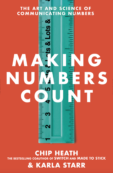Switch goes on sale today — I can’t wait to see it in a bookstore. If you’re looking for immediate gratification, you can find links to all the online retailers here. (And Amazon is selling it for the freakishly low price of $13.)
Read the first chapter of Switch
We’ve just posted the first chapter of Switch here — check it out. (And if you want a nicely-formatted PDF of the first chapter, sign up for our free resources section.)
Underachieving multitaskers
Stanford researchers ran a series of experiments, hoping to find evidence that people who multitask have enhanced cognitive abilities that allow them to juggle multiple media effectively. Instead, they came away disappointed: The multitaskers were worse than a control group at everything they tested.
“We kept looking for what they’re better at, and we didn’t find it,” said Ophir, the study’s lead author and a researcher in Stanford’s Communication Between Humans and Interactive Media Lab. …
“They’re suckers for irrelevancy,” said communication Professor Clifford Nass, one of the researchers whose findings are published in the Aug. 24 edition of the Proceedings of the National Academy of Sciences. “Everything distracts them.”
I feel like the next logical step is some kind of pseudo-Olympic event to settle this once and for all. Multitaskers vs. One-Track-Minders. Cage match.
Quote of the day
US Airways Customer Service Line: “Your call will be answered in:
One hundred.
Fifty.
Four.
Minutes.”
Making math concrete
Steven Strogatz, an applied math prof at Cornell, has started a series on the NYT site to re-teach basic math from an adult perspective, with the goal to show “why it’s so enthralling.”
I love the second installment, which explores the way that using rocks in place of digits (i.e., six rocks rather than the number “6”) can provide unexpected insight on seemingly tough problems:
For example, instead of adding just two odd numbers together, suppose we add all the consecutive odd numbers, starting from 1:
1 + 3 = 4
1 + 3 + 5 = 9
1 + 3 + 5 + 7 = 16
1 + 3 + 5 + 7 + 9 = 25
The sums above, remarkably, always turn out to be perfect squares. (We saw 4 and 9 in the square patterns discussed earlier, and 16 = 4 × 4, and 25 = 5 × 5.) A quick check shows that this rule keeps working for larger and larger odd numbers; it apparently holds all the way out to infinity. But what possible connection could there be between odd numbers, with their ungainly appendages, and the classically symmetrical numbers that form squares? By arranging our rocks in the right way, we can make this surprising link seem obvious — the hallmark of an elegant proof.
The key is to recognize that odd numbers can make L-shapes, with their protuberances cast off into the corner. And when you stack successive L-shapes together, you get a square!




